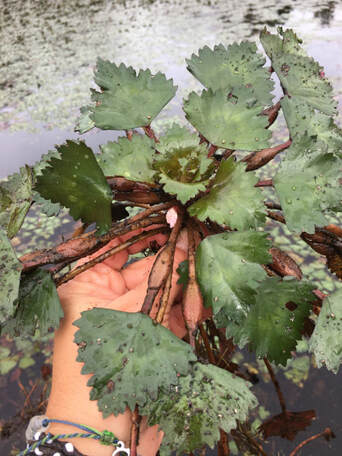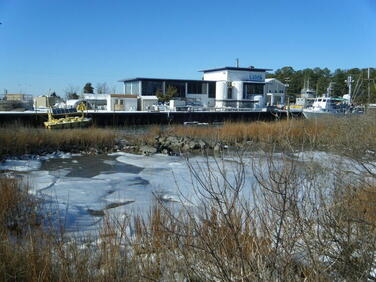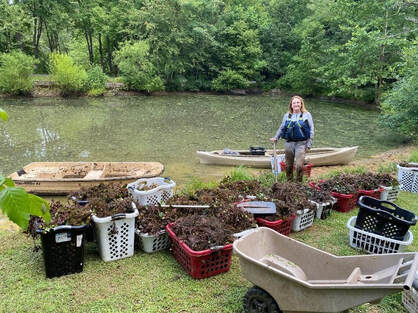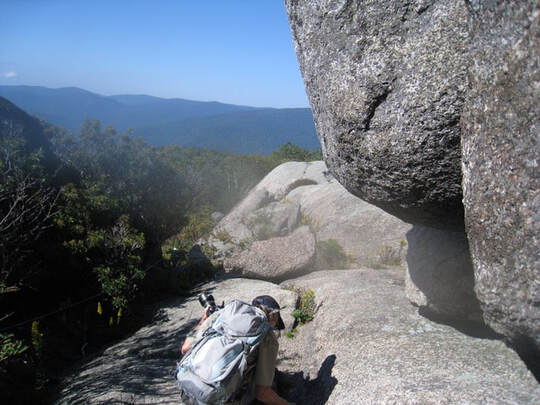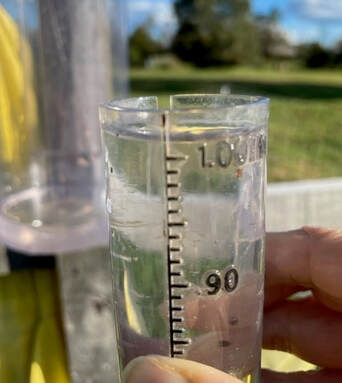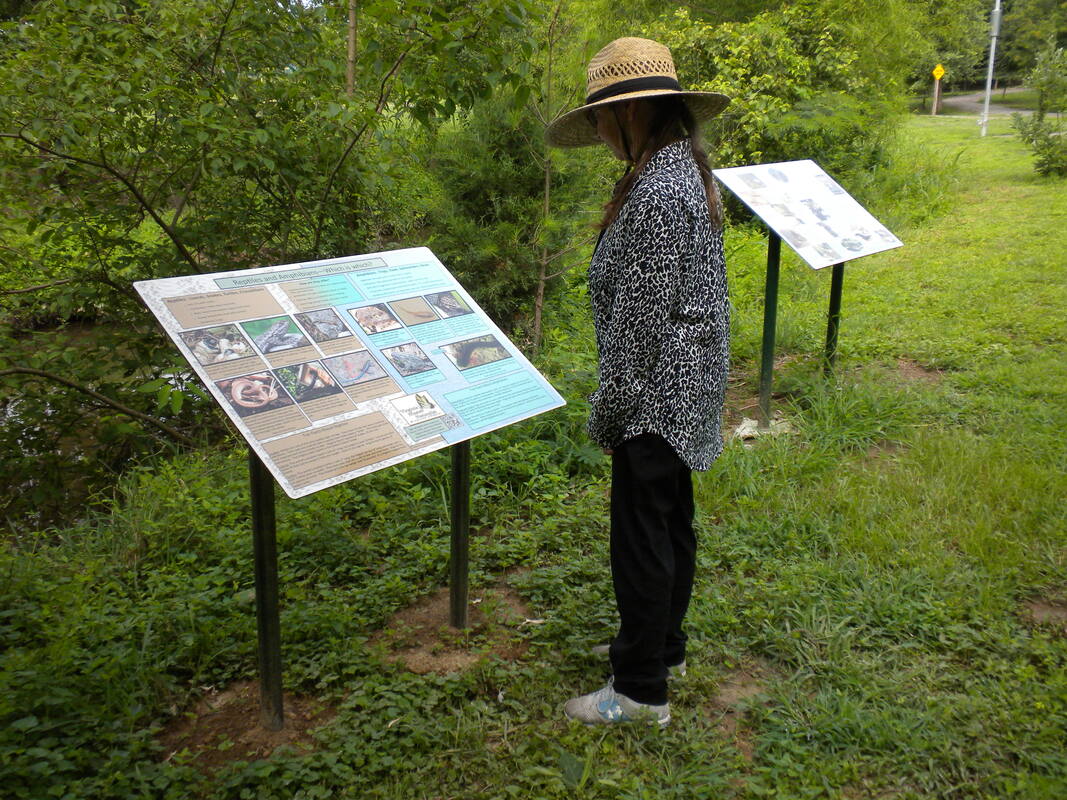Each quarter, we invite VMN chapters to share stories of volunteers’ awards and accomplishments. Our Laurels posts are not only a way to provide recognition to those volunteers, but also an opportunity to inspire other volunteers. If you are inspired by one of the projects or accomplishments mentioned here and want more information, please contact the VMN state office and we’ll put you in touch!
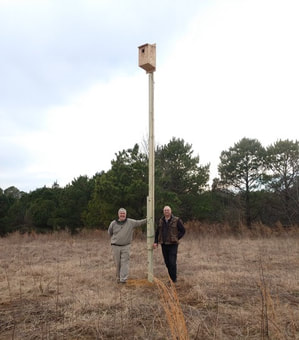 VMN volunteers Dave Harlan and Mark Sopko next to a kestrel nest box at Machicomoco State Park. Nest boxes for American Kestrels are placed fifteen feet above the ground. Photo by Josh Mazzatenta, Virginia State Parks.
VMN volunteers Dave Harlan and Mark Sopko next to a kestrel nest box at Machicomoco State Park. Nest boxes for American Kestrels are placed fifteen feet above the ground. Photo by Josh Mazzatenta, Virginia State Parks.
Volunteers From Two Chapters Team Up to Help American Kestrels at Machicomoco–Contributed by Mark Sopko, VMN Peninsula Chapter
Recently, Virginia Department of Conservation and Recreation (DCR) with the help of Park Ranger Emily Harlan, has given permission for volunteers to place several American Kestrel nest boxes on Machicomoco State Park.
Machicomoco State Park has been the residence of at least one American Kestrel (Falco sparers) since 2018. Data collected from migration counts, the US geological Survey’s Breeding Bird Survey and nest-box monitoring programs show steep declines in American Kestrel populations throughout North America, particularly in the North East. Lack of suitable nestling cavities can severely limit the American Kestrel numbers. The presence of a resident on Machicomoco is a huge plus toward conservation of this species.
Both the Middle Peninsula and Peninsula chapters of the Virginia Master Naturalist program joined together and volunteered to place two nest boxes on park grounds. This project was organized with he help of Susan Crockett, from the Middle Peninsula chapter and Mark Sopko from the Peninsula chapter. Ed Pels built the nest boxes and Dave Harlan designed the poles, both from the Middle Peninsula chapter. Dave and Mark placed the nest boxes on Machicomoco. The volunteers hope that the boxes will attract the kestrels to nest on the park, keeping these beautiful little raptors on Machicomoco for future generations.
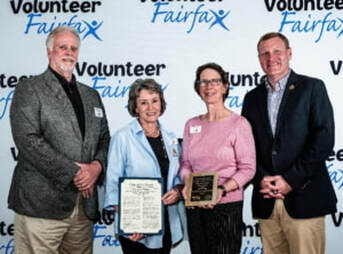 From left to right: Jerry Nissley, Marilyn Parks, Janet Quinn, and Chairman Jeffrey C. McKay – Fairfax County Board of Supervisors. Photo by Edward Marion.
From left to right: Jerry Nissley, Marilyn Parks, Janet Quinn, and Chairman Jeffrey C. McKay – Fairfax County Board of Supervisors. Photo by Edward Marion.
Fairfax Chapter Receives Environmental Sustainability Award—
Shared from the Fairfax Chapter blog by Janet Quinn with text by Jerry Nissley, VMN Fairfax Chapter
On Wednesday, April 20th, Volunteer Fairfax, together with the Fairfax County Board of Supervisors, celebrated the 149 nominees, 11 category winners, and 10 Community Champions during its 30th Anniversary Awards Program. The 2022 program consisted of a virtual awards program where the winners were announced to the public and an in-person reception at the Stacy C. Sherwood Center in Fairfax City where the winners received their awards.
Fairfax County Volunteer Service Awards highlight the achievements of volunteers in several distinct award categories. The 2022 Environmental Sustainability Award was presented to the Fairfax Chapter of the Virginia Master Naturalists (FMN). This award honors volunteers who work to protect and beautify our environment and natural surroundings, advocate for the preservation of our planet and strive to instill these values for our community.
During the virtual portion of the program, previously recorded video dialogues were shown detailing mission, goals, and achievements that supported each service category award. FMN President Marilyn Parks and FMN Member Chair, Mike Garth, were the video presenters for the Fairfax Chapter and they more than carried the day by offering both quantifiable metrics for FMN 2022 achievements and gracious praise and recognition for all the FMN volunteers that are at the heart of this award. FMN Communications Co-chair Janet Quinn and FMN Jerry Nissley accompanied Marilyn to the reception where Marilyn accepted the award on behalf of FMN.
In January 2022, the FMN annual report was shared with members in a newsletter. Marilyn realized the crux of what our chapter had accomplished really didn’t shine through. Our service deserved further recognition, so she wrote up and submitted a nomination to Volunteer Fairfax for consideration.
In the nomination Marilyn highlighted some important 2021 FMN accomplishments. Most notable were – 197 FMN members volunteered 15,500 hours; a 25% increase in 2021 over 2020! This increase was a surprise given 2020 over 2019 hours had resulted in a 15% reduction of hours (first year of COVID outbreaks). FMN delivered 25% more hours to our partners and sponsors in the midst of a 2nd year of COVID. Let that sink in. We were out there working and spending time on 106 projects, making a difference and helping to preserve and protect the natural environment within Fairfax county. We recruited, trained and graduated 40 students – without the benefit of meeting at the county Government Center (all via Zoom).
This is attestation to the fidelity of all FMN volunteers that carried on their substantial enthusiasm for service in support of our partner organizations, our communities, our local, regional and state parks, and our growing network of service allies.
Marilyn concludes by saying, “I hope members are pleased with their chapter, happy with their choice of volunteering to serve nature, and thrilled to be recognized and named the Volunteer Fairfax – Environmental Sustainability Award winner for 2022”.
The Honorable Gerry Connolly (Congressman 11th District Virginia) was the keynote speaker and engaged the audience with anecdotes of volunteerism and serving in local government. He said, “Volunteers are a testament to the strong ethos of public service and volunteerism that exists in Fairfax County and is one of many reasons why this community is such a wonderful place to live.”
In commemoration, Congressman Connolly had this commendation along with additional comments and a list of all award winners entered
into the Congressional Record of the 117th Congress recognizing the 2022 service award winners. FMN in the Congressional Record!

Great Backyard Bird Count participants at Sky Meadows State Park. Photo by Connie McCabe.
Old Rag Chapter Leaders Engage Volunteers and the Public—
Contributed by Charlene Uhl, VMN Old Rag Chapter
The Old Rag Master Naturalist chapter works hard to offer opportunities to its members in Citizen Science, Stewardship and Education. Here are some examples over the last three months of the ways we are working to engage our members:
Citizen Science was front and center in our chapter’s participation in Cornell’s Great Backyard Bird Count. We hosted five locations across four days in February, including a state park, a county park, and three private farms. Thirty-five participants and eight guides participated. Data reported to the Cornell Lab for Ornithology included 119 species and 668 total birds.
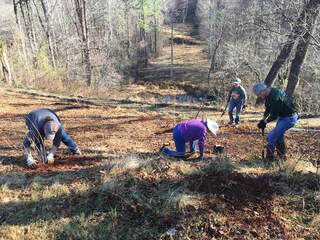 Old Rag Master Naturalist volunteers plant new trees and shrubs in a power line right-of-way in Rappahannock County Park. Photo courtesy of Rappahannock County Park.
Old Rag Master Naturalist volunteers plant new trees and shrubs in a power line right-of-way in Rappahannock County Park. Photo courtesy of Rappahannock County Park.
Stewardship was also an important opportunity for our members. Ten volunteers cleared a section of the right-of-way in Rappahannock County Park under electric lines managed by the Rappahannock Electric Cooperative (REC). This was followed by planting 42 understory trees and shrubs, purchased with a donation from the Rappahannock Garden Club, to build a low growth native plant wildlife habitat and viewing area of the Rush River. We were heartened to learn from one of our partners – the Clifton Institute – that REC rights of way they have studied are rich with natives – even when they have been cleared with herbicides for years. The project leaders have entered into a conversation with the Clifton Institute to survey the remaining REC areas in the park and determine the best preservation/restoration choices.
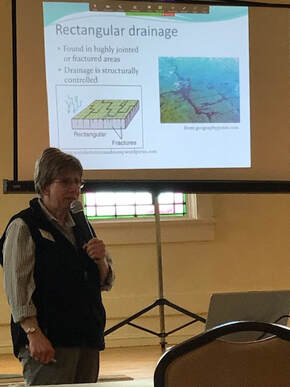 Dorothy “Tepp” Tepper presenting on hydrology. Photo by Cindy Colson.
Dorothy “Tepp” Tepper presenting on hydrology. Photo by Cindy Colson.
Not to be short-changed, Education offered two exciting programs. A class on Hydrology, Floods and Debris Flows was offered to ORMN members and as an optional program for our Basic Training Class. A total of 22 participants learned about the development of caves produced by groundwater flow; landforms associated with streams like waterfalls, floodplains and meanders; and historic debris flows caused by extreme weather events, such as those in Nelson County, 1969 and in Madison County, 1995. The class was taught by our resident hydrogeologist – Dorothy “Tepp” Tepper, a Scientist Emeritus and former employee of the U.S. Geological Service.
Our second Education program was the Siegen Forest Ephemerals Walk. Over 35 people toured the old growth forest on the ground of Germanna Foundation’s Siegen Forest. An amazing variety of ephemerals were on display, including Virginia bluebells, yellow trout lily, mayapple, spring beauties and trilliums. An additional perk for attendees was the opportunity to walk up onto the rock bluffs overlooking the Rapidan River to see an eagle’s nest, including parents coming and going and the head of one eaglet popping above the ring of the nest. This walk was open to the public and organized in partnership with the Central Rappahannock Master Naturalist chapter and the Germanna Foundation.

Virginia bluebells observed on the Siegen Forest Walk. Photo by Mariana Zechini.

Jim Gallagher, self-portrait
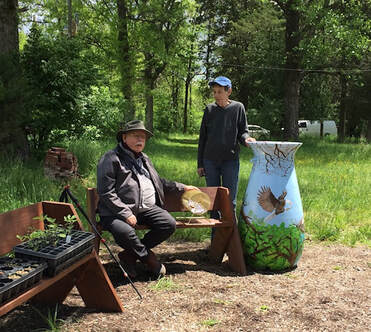 Jim Gallagher with one of his painted rain barrels at Merrimac Farm Wildlife Management Area. Photo by Kathy and Pete Madsen.
Jim Gallagher with one of his painted rain barrels at Merrimac Farm Wildlife Management Area. Photo by Kathy and Pete Madsen.
Recognizing the Life and Contributions of Jim Gallagher, VMN Merrimac Farm Chapter—
Contributed by Valerie Huelsman, VMN Merrimac Farm Chapter
Unexpectedly this spring our friend and fellow VMN James (Jim) Gallagher of the Merrimac Farm Chapter passed away. He had been battling cancer for several years with grace and strength while still finding joy and meaning supporting the natural world.
A part of the 2010 Merrimac Farm BTC, Jim was one of our longest serving members since the founding of our Chapter in 2008. He served on the Board of Directors for several years as Secretary and was always willing to help out with Chapter projects including being a co-instructor for training classes, representing our Chapter during education and outreach events, and helping with stream clean ups. Participating in citizen science projects was another passion, especially for bio-blitzes, the i-Naturalist City Nature Challenges and Audubon Christmas Bird Counts. Along with his wife Judy, he shared his knowledge by creating many entertaining (and challenging) ‘Stump the Master Naturalist’ quizzes.
Jim was also our resident Chapter artist, highly regarded for his contributions to many projects with the Prince William Conservation Alliance and Merrimac Farm Wildlife Management Area. This includes the billboard mural in front of the Stone House and a contribution of a beautifully painted rain barrel auctioned off each year at the Bluebell Festival to support efforts at Merrimac Farm WMA. A bench he painted in front of the Stone House shows his whimsical humor and artistry, (next time you visit look for the hidden four leaf clover). The bench sits near the opening in the garage door that he decorated in appreciation for our local eastern ratsnake that uses it as a ‘front door’ to enter the garage. He was always very willing to share his artistic talents for our Chapter as well, in 2017 he designed our iconic Chapter logo.
As we miss Jim we will remember all of his contributions and good nature with great fondness.
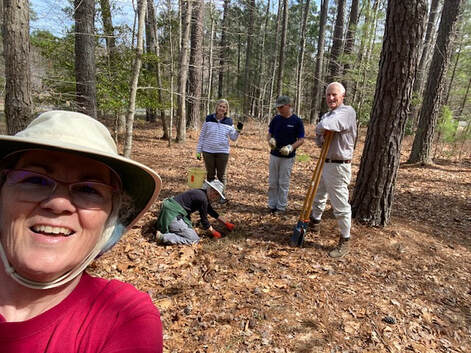 Judy Kinshaw-Ellis with some of her fellow tree planters. Photo by VMN Historic Rivers Chapter.
Judy Kinshaw-Ellis with some of her fellow tree planters. Photo by VMN Historic Rivers Chapter.
A True Tree Planting Addict–Contributed by Connie Reitz and Rick BrownThe Historic Rivers Chapter is very fortunate to have had Judy Kinshaw-Ellis as a member since 2015. She has a self-confessed addiction for planting trees wherever she can get permission to plant. Judy is a cross between Johnnie Appleseed and Tom Sawyer in that she loves to plant trees and is adept at getting other people to help her. However, unlike Tom, she does quite a bit of the physical labor herself.
When asked what got her started she admits, “It hasn’t always been this way. I haven’t always planted trees. But now, I do have a real love for adding to the plant diversity of the forests and swamps of James City County. Planting hundreds of trees with friends, old and new, has become a sort of obsession.”
As a young girl, Judy explains, “I watched my dad plant a nut that grew into a tree. I ate five types of apples off one tree because of his grafting skills. I watched the apple trees he planted grow old, even though he passed away when I was young. Could this love of trees have been passed along to me so many years ago? I like to think so.”
Judy’s obsession has been enhanced because she is also been trained as a Master Gardener and Tree Steward. Her first planting effort that started innocently as a 2018 Master Gardener Tree Steward Project in James City County’s Freedom Park, expanded into a much wider planting program. That project explored what trees the early freed-slave settlers of Freedom Park would have used and focused on adding some of the plants that those settlers would have used for food in addition to trees that would make the forest more like it would have been in the early 1800s. A Trees Virginia grant paid for the first 100 or so seedlings that were planted plus the first round of tree tags that were installed on established trees in the Settlement. That Tree Steward Project also introduced Judy to all the wonderful state forestry seedling programs where states sell a wide variety of seedlings at a reasonable cost.
Following phase one of the Tree Steward Project, she ordered another 400 seedlings, which arrived the second week of March 2020, just as the Covid pandemic shut down all Master Gardener volunteer activities. Fortunately, Judy had a group of her Master Naturalist friends who were willing to get out in the fresh air and plant some trees. The group, whom Judy lovingly dubbed “The Dream Team,” was made up of Ginny Broome, Jeanette and Keith Navia, Bill Grass, and Judy’s understanding husband Drew Ellis. She potted 100 seedlings for planting that fall while the six planted the other 300.
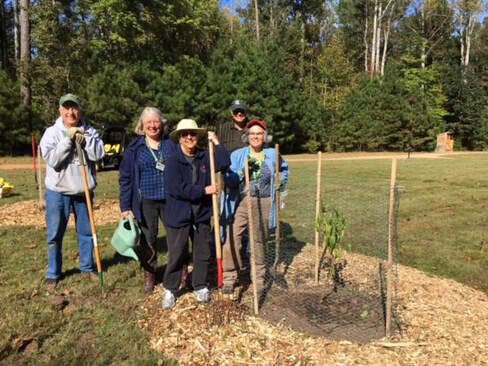 Judy Kinshaw-Ellis at one of many tree planting volunteer events. Photo by VMN Historic Rivers Chapter.
Judy Kinshaw-Ellis at one of many tree planting volunteer events. Photo by VMN Historic Rivers Chapter.
By the time the various state forestry departments opened for sales the following fall, Judy was ready to order again, but because Covid was still raging, she limited her order to only 100 trees this time. By the time the trees would arrive in March of 2021, vaccinations were starting to be distributed and people were ready to work outside. The Dream Team was called back into service. When time came for fall orders that year she ordered another 400 trees.
In January 2022, the Virginia Native Plant Society named the buttonbush, as the Virginia Native Plant of the year. After consulting with people from the Williamsburg Botanical Garden and the local John Clayton Chapter of the Native Plant Society about splitting the order, Judy ordered 1000 buttonbushes because that allowed for a volume discount. The trees arrived right on time mid-April. Once the WBG and NPS received their seedlings, volunteers from t
he Historic Rivers Chapter and the local Master Gardener Tree Stewards volunteered and planted the rest. The good news is that buttonbushes grow in wet, swampy areas, which makes them easy to plant. Judy led her team of diverse volunteers to plant locally at Jamestown Settlement plus James City County parks including Freedom Park, Warhill Sports Complex, the James City County Marina, and Greensprings Trail.
To date Judy has enlisted dozens of volunteers, from several community organizations to plant more than 1700 trees and shrubs. They have collectively donated numerous volunteer hours at six locations. Judy admits, “Planting a tree is fun. Planting 100 is invigorating. 1600 trees may seem a bit crazy.”
Planting seedlings is not easy work, but it is very rewarding. Judy emphasized that she appreciates the efforts of everyone who has been involved in her obsession and promises that there will be more seedlings to come. She is truly the embodiment of the quote from poet & author Nelson Henderson, who said, “The true meaning of life is to plant trees, under whose shade you do not expect to sit.” Our Chapter, Commonwealth and planet have been truly enriched because of Judy’s efforts.
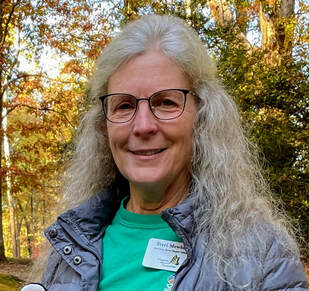 VMN volunteer Terri Mewborn. Terri started with the VMN program in the Merrimac Farm Chapter and has since led efforts to launch the new Southern Piedmont Chapter. Photo by Virginia State Parks.
VMN volunteer Terri Mewborn. Terri started with the VMN program in the Merrimac Farm Chapter and has since led efforts to launch the new Southern Piedmont Chapter. Photo by Virginia State Parks. 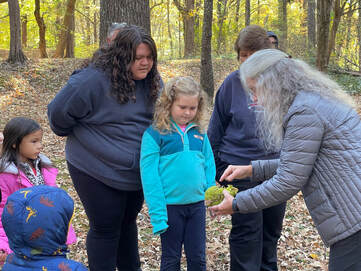 Terri introducing the group to an Osage orange. Photo by Virginia State Parks.
Terri introducing the group to an Osage orange. Photo by Virginia State Parks.
 The Interpretive Program Plans that Terri wrote are available to other interpreters, both staff and volunteers, at Occoneechee State Park. Photo by Virginia State Parks.
The Interpretive Program Plans that Terri wrote are available to other interpreters, both staff and volunteers, at Occoneechee State Park. Photo by Virginia State Parks.
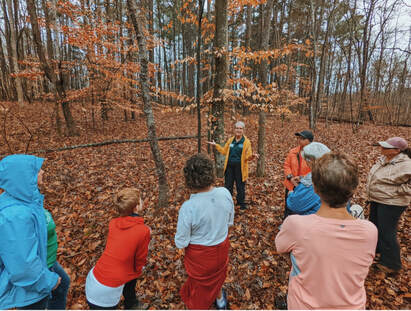 Terri Mewborn leading a first day hike at Occoneechee State Park on January 1, 2022. Photo by Virginia State Parks.
Terri Mewborn leading a first day hike at Occoneechee State Park on January 1, 2022. Photo by Virginia State Parks.











